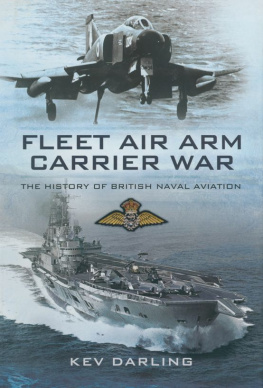Table of Contents
Praise forWings on my Sleeve
Fascinating reading... Truly a living legend among aviation enthusiasts, his amazing life story is quite literally stranger than fiction. If you only buy one aviation book this year, make sure its this one Todays Pilot
The stories beggar belief Guardian
A fascinating story... full of absorbing information and insight Times Literary Supplement
Copiously illustrated, filled with insights, opinion, anecdotes and observations, this is a gem of a book Navy News
A fascinating story... For anyone interested in aviation, this is required reading Aeroplane magazine
Eric Brown is in the Guinness Book of Records for having flown more aircraft types (487) than any other pilot in the world. His record is unlikely ever to be broken. Now 88, Captain Brown CBE , DSC, AFC, KCVSA, became a test pilot during the Second World War and commanded the RAE Aerodynamics Flight at Farnborough. He played a key role in the design of an entire generation of aircraft. No other man alive today can claim to have interviewed the top Nazis, flown their jet aircraft or tested so many experimental machines. Today he remains a consultant for the Royal Navys latest aircraft carrier design.
Wings on My Sleeve
CAPTAIN ERIC BROWN
Orion
www.orionbooks.co.uk
A Weidenfeld & Nicolson ebook
FRONTISPIECE
Winkle Brown makes the worlds first ever jet-landing
on an aircraft carrier
A PHOENIX PAPERBACK
First published in Great Britain by Arthur Barker
Revised and updated edition published
by Weidenfeld & Nicolson in 2006
This paperback edition published in 2007
by Phoenix, an imprint of Orion Books Ltd, Orion House,
5 Upper St Martins Lane, London WC2H 9EA
10 9 8 7 6 5 4 3 2 1
Copyright Eric Brown 2006
The right of Eric Brown to be identified as the author of this work has been asserted by him in accordance with the Copyright, Designs and Patents Act 1988.
All rights reserved. No part of this publication may be reproduced, stored in a retrieval system, or transmitted, in any form or by any means, electronic, mechanical, photocopying, recording or otherwise, without the prior permission of the copyright owner.
A CIP catalogue record for this book is available from the British Library.
eISBN 978 0 2978 5690 0
Designed by Blacker Design
www.orionbooks.co.uk
This ebook produced by Jouve, France
To my wife Lynn and son Glenn
who had to endure
so many anxious years
Foreword
By the late Sir Morien Morgan CB MA FRAeS
Head of Aero Flight Section at RAE (1944-48)
President of The Royal Aeronautical Society (1967-68)
Director of RAE Farnborough (1969-78)
THIS IS THE STORY of a truly remarkable pilot. He has been called the greatest test pilot that Britain ever produced, and also the greatest naval aviator of all time. The facts do not belie these claims. He was decorated more times than any other British test pilot and Fleet Air Arm pilot, receiving the MBE, OBE, CBE, DSC, AFC, and Kings Commendation for Valuable Service in the Air.
Landing a conventional military aeroplane on an aircraft carrier is generally accepted as the supreme test of piloting skill. Captain Brown has a world record of 2,407 deck landings to his credit, including many world firsts. He has also recorded more catapult launches than any other pilot.
Extensive research indicates that he has flown more types of aircraft than any other pilot in the world, and certainly the most astonishing assortment, ranging through gliders, fighters, bombers, airliners, amphibians, flying boats and helicopters as well as prone and supine position aircraft, and aircraft propelled by virtually every known type of power plant.
He was Chief Naval Test Pilot at RAE Farnborough, and became the first naval officer to command the world renowned Aerodynamics Flight, which was regarded as the top post in experimental research test flying. He lived through the highly dangerous days when attempts to break the sound barrier cost many lives. He himself led a charmed life, not because of luck but by virtue of supreme flying skill, a skill which was recognized by his first Flying Instructor, who classified him as Exceptional - an accolade not lightly given.
To those who have witnessed his superb aerobatic displays or flown as his test observer, there can be no gainsaying that assessment. His operational record only emphasizes the point.
This is the story of a man who has lived more fully in the air than any other pilot of his generation, and at the same time it is an important contribution to the history of the Fleet Air Arm and of test flying in Britain.
Graduation day.
Chapter 1
I WAS BORN IN EDINBURGH of parents from the Scottish Borders, and from my early days was fascinated by the portrait that hung in our lounge of my father in RFC uniform during World War I. He had been a balloon observer, spotting beyond enemy lines and also being a prime target for German fighter aircraft. Although it was also a high-risk game being a pilot in the RFC, he apparently felt that this would be his preferred option and so he found himself posted to flying training, which he barely completed before the Armistice was signed. I was born in January 1919, so was a product of the RFC, and somehow I felt flying was in my blood.
As a schoolboy I won a scholarship from my local primary school to Edinburghs historic Royal High School, with its classical Greek temple buildings set in the heart of the Scottish capital. There I had a most happy schooling with academic honours (runner-up to Dux of School) and sporting successes in rugby (1st XV) and gymnastics (school champion).
About half-way through my school life my mother died, and I moved with my father to the Borders, so that I now had to commute by train to school every day. In 1936 my father took me to the Olympic Games in Berlin, and as an ex-RFC pilot he was invited to welcoming events by former World War I German pilots now serving in the newly-resurfaced Luftwaffe. There I met Ernst Udet, the top scoring fighter ace after Richthofen, and also the aviatrix Hanna Reitsch, who was giving a sailplane aerobatic display at a venue close to the Olympic stadium. These two very different characters were to have a considerable impact on my life. Udet was a complete extrovert, who had become a world-famous stunt pilot after World War I, and had been persuaded, rather against his will, by Goering to join the new Luftwaffe as Colonel in charge of the Technical Department of the Air Ministry. Hanna Reitsch, on the other hand, was the top female sailplane pilot in the world, an intense, strong-minded woman, filled with ambition and determination. Both were mad keen aviators, courageous and skilful, and were to play key roles in the aviation history of Hitlers Third Reich.

Bcker Jungmann trainers which were standard in the pre-World War II Luftwaffe. It was a flight in a Jungmann as a young schoolboy, with Colonel Ernst Udet, a World War I ace and famous aerobatic pilot, in Berlin that determined the author to become a fighter pilot.














